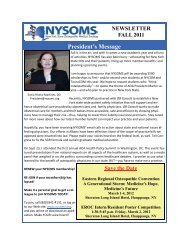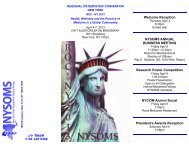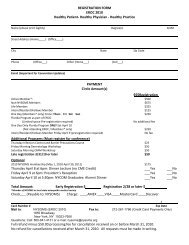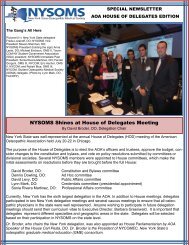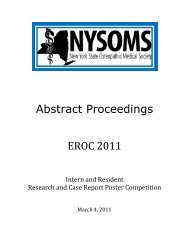OMT In Pregnancy â NYSOMS
OMT In Pregnancy â NYSOMS
OMT In Pregnancy â NYSOMS
Create successful ePaper yourself
Turn your PDF publications into a flip-book with our unique Google optimized e-Paper software.
OMM in <strong>Pregnancy</strong><br />
Myra Cummings Mabry, MEd, MBA, DO
Osteopathic Manipulative Medicine<br />
(OMM) is a body-based modality in<br />
which the patient is evaluated and<br />
treated as a whole to improve<br />
physiologic functioning and remove<br />
impediments to optimal health and<br />
functioning
Discovering you’re pregnant…
And then reality sets in….
Physiologic Changes<br />
in <strong>Pregnancy</strong>
Cardiovascular<br />
• Elevated progesterone causes<br />
smooth muscle relaxation<br />
• Cardiac output h<br />
• SVR i<br />
> 24wks, return to normal
Pulmonary<br />
• Tidal volume h<br />
- progesterone<br />
• Total Lung Capacity i<br />
-elevation of diaphragm<br />
• Dyspnea of pregnancy<br />
-h CO2 gradient between mother and fetus
Gastrointestinal<br />
• Nausea, vomiting<br />
- h estrogen, progesterone, hCG<br />
• Reflux<br />
- h gastric emptying time,<br />
- i sphincter tone<br />
• Constipation<br />
- i motility,<br />
- h water absorption
Renal<br />
• Kidneys enlarge<br />
• Ureters dilate<br />
pyelonephritis<br />
• h GFR, i BUN , i Cr<br />
• h Renin – h Angiotensin - h Aldosterone
Hematology<br />
• Plasma volume h<br />
- hemodilutional anemia<br />
• WBC h<br />
- mean = 10.5<br />
• Slight i platelets<br />
• Hypercoagulability<br />
-h fibrinogen and Factors VII-X
Endocrine<br />
• h Estrogen<br />
- by placenta, ovaries lesser degree<br />
• h Progesterone<br />
- relaxation of smooth muscle<br />
• h hCG<br />
- first by the corpus luteum, then by the placenta<br />
• h hPL<br />
- insulin antagonist<br />
• Breast swelling/tenderness
Key Points for OMM in <strong>Pregnancy</strong><br />
• OMM can be used throughout pregnancy, during<br />
labor and post partum<br />
• Always treat patient in whichever position they are<br />
most comfortable!<br />
• Usually supine or side-lying is best<br />
• Diagnose, then treat the side that is worst<br />
• Use patient’s own body weight to help you and<br />
help patient to relax<br />
HVLA is a relative contraindication in pregnancy!
Routine Problems During <strong>Pregnancy</strong><br />
• Back pain<br />
• Constipation<br />
• Edema<br />
• Gastroesophageal<br />
Reflux Disease<br />
• Hemorrhoids<br />
• Round Ligament Pain<br />
• Urinary Frequency<br />
• Varicose Veins<br />
• Headaches/migraines<br />
• Sinusitis<br />
• Neck aches<br />
• Joint pain (carpal<br />
tunnel syndrome)<br />
• Sciatica<br />
• Hip pain/ Low back<br />
pain<br />
• Pubic pain
Back Pain<br />
• Shift center of gravity increase in lumbar<br />
lordotic curve<br />
• As uterus grows, there is dextrorotation of<br />
uterus into pelvis<br />
• Subtle rotational component causes torsional<br />
stress pattern up the spine to restrict motion of<br />
chest, ribs, and diaphragm
Common Findings in Back Pain<br />
• <strong>In</strong>creased lumbar lordosis<br />
• Myofascial strains<br />
• Paraspinal muscle strain or muscle spasm<br />
• Lumbar-sacral junction compression
OMM Treatment of Back Pain<br />
Soft tissue techniques<br />
• Myofascial release<br />
• Facilitated positional release<br />
• Balanced ligamentous tension<br />
- direction of ease<br />
• Lumbo-sacral decompression<br />
• Modified lumbar roll
Hip pain/Sciatica<br />
Anatomy:<br />
• Sciatic nerve roots L4-L5-<br />
S1-S2-S3<br />
• Exits out greater sciatic<br />
notch along with piriformis<br />
muscle (innervated by S1-S2)<br />
• <strong>In</strong> pregnant females, likely<br />
due to same rotational<br />
component from<br />
enlargement of uterus
Common Findings in<br />
Hip pain/Sciatica<br />
• L5 slides anterior <br />
• ASIS compression<br />
• Sacral-iliac compression<br />
• <strong>In</strong>terosseous sacral compression sciatica<br />
• Sacral Somatic Dysfunction<br />
• Sacral torsions,<br />
• Sacral base anterior/posterior,<br />
• Unilateral sacral flexion/extension
Treatment of Hip pain/Sciatica<br />
• Sacral Rock<br />
• Sacral-iliac decompression<br />
• <strong>In</strong>terosseous sacral decompression<br />
• Sacral inhibition at S2-S3<br />
• L5-S1 decompression<br />
• Cupping the sacrum place palms on sacral<br />
poles and take bone into direction of ease
Pubic pain<br />
• Relaxin and progesterone help to loosen ligaments<br />
extra laxity and pelvic pressure during pregnancy<br />
• Pain from excessive levels of hormones, extra<br />
sensitivity to hormones, pelvic misalignment, or<br />
combination of above<br />
• Symptoms:<br />
• pubic bone very tender to palpation,<br />
• pain when lifting one leg at a time or parting the<br />
legs, walking, turning over in bed, strong round<br />
ligament pain,<br />
• may recur or progress with each pregnancy
Pubic pain<br />
• Risk factors:<br />
• Multiparity<br />
• h/o macrosomic infant<br />
• Pre-existing problems with joint<br />
• Past pelvic or back pain<br />
• Past trauma (including obstetric or gynecological)
Findings in Pubic Pain<br />
• One iliac more superior than other<br />
• ASIS/PSIS more superior on one side<br />
• One pubic bone more superior than other<br />
• Leg length discrepancy<br />
• Named by side of (+) ASIS compression<br />
• Also check for inflare or outflare
Treatment of Pubic Pain<br />
• Long lever technique - gap<br />
sacral-iliac, slight<br />
adduction, then lean body<br />
up or down to counteract<br />
dysfunction<br />
• Counterstrain – anterior<br />
tenderpoint L5 is 1 cm<br />
lateral to pubic symphysis<br />
on superior ramus pt<br />
supine, knees and hips<br />
flexed and rotated away
Treatment for Pubic Pain<br />
Superior Pubic dysfunction<br />
<strong>In</strong>ferior Pubic dysfunction<br />
*For innominate shears, add subtle abduction component
Other Common Problems & Treatments<br />
• Headaches/migraines<br />
• condylar decompression<br />
• occipital-mastoid suture release<br />
• cervical soft tissue<br />
• Sinusitis<br />
• venous sinus drainage<br />
• inhibition of confluence of sinuses<br />
• Neck Pain<br />
• condylar decompression<br />
• facilitated positional release,<br />
• counterstrain
Other Common Problems & Treatments<br />
• GERD/nausea & vomiting<br />
• r/o other causes first<br />
• balance sympathetics<br />
• check T5-T9 for TART changes treat by<br />
putting segments into direction of ease<br />
• chapman points (anterior along ribs 5-9)<br />
• Constipation<br />
• hydrate first and modify diet<br />
• release of sacrum and pelvic splanchic nerves to<br />
the rectum
Other Common Problems & Treatments<br />
• Dyspnea<br />
• r/o other causes<br />
• check for posterior diaphragm restriction <br />
diaphragm release<br />
• check T2-T7 for TART balanced ligamentous<br />
tension<br />
• Check ribs for restriction rib raising<br />
• Edema in legs or varicose veins<br />
• <strong>In</strong>crease lymphatic return and release diaphragm<br />
• spreading of lymph behind knee, thoracic inlet<br />
release, lymphatic pump if tolerable
Sympathetic Nerve <strong>In</strong>nervation<br />
Head and Neck<br />
Heart<br />
Respiratory<br />
Upper GI Tract<br />
Stomach, Liver, GB, Spleen, head of Pancreas,<br />
beg. portion of Duodenum<br />
Middle GI Tract<br />
Rest of pancreas, Duodenum, Jejunum, Ilium,<br />
Ascending colon, prox 2/3 of transverse colon<br />
Lower GI Tract<br />
Distal 1/3 transverse colon, Descending colon,<br />
Sigmoid colon, Rectum<br />
Kidneys<br />
Adrenal Medulla<br />
T1 – T4<br />
T1 – T5<br />
T2 – T7<br />
T5 – T9<br />
T9 – T12<br />
T12 – L2<br />
T11 – L1<br />
T10
Sympathetic Nerve <strong>In</strong>nervation<br />
Upper Ureters<br />
Lower Ureters<br />
Bladder<br />
Gonads<br />
Uterus and cervix<br />
Erectile tissue of penis/clitoris<br />
Extremities<br />
Upper (arms)<br />
Lower (legs)<br />
T10 – L1<br />
L1 – L2<br />
T11 – L2<br />
T10 – T11<br />
T10 – L2<br />
T11 – L2<br />
T5 – T7<br />
T10 – L2
OMM in Prenatal Care: Research<br />
King et al, JAOA, December 2003<br />
• Study conducted in 4 cities: Chicago; Kirksville;<br />
Bangor, Maine; San Diego<br />
• Randomly selected equal numbers of women to receive<br />
<strong>OMT</strong> or not receive <strong>OMT</strong> (160 vs. 161)<br />
• Techniques applied: muscle energy, myofascial release,<br />
ligamentous articular strain, balanced membranous<br />
tension, HVLA, counterstrain, cranial
<strong>OMT</strong> Research Results<br />
# Women Avg. Age # times<br />
<strong>OMT</strong><br />
160<br />
161<br />
28.32<br />
26.39<br />
4.0<br />
0<br />
Primigravida<br />
59<br />
66<br />
Received<br />
<strong>OMT</strong><br />
# MSAF PTD Forceps C/S<br />
160 12 6 10 26<br />
No <strong>OMT</strong> 161 34 19 17 29<br />
* MSAF- meconium stained amniotic fluid,<br />
PTD- preterm delivery, C/S- Cesarean section
During Delivery<br />
• OMM can improve body mechanics to help<br />
reduce the amount of time needed to push<br />
• Prevent need for vacuum assisted vaginal<br />
delivery, forceps assisted vaginal delivery,<br />
episiotomy<br />
• Prevent weakening of pelvic floor<br />
• Leads to uterine prolapse, bladder prolapse,<br />
incontinence or other bladder/bowel problems<br />
as women reach menopause
Treatments during delivery<br />
• Limited by how relaxed patient is and whether<br />
she had an epidural<br />
• Sacral-iliac decompression<br />
• expands pelvic outlet<br />
• allows leg muscles to release (prevent cramping)<br />
• allows patient to relax so may feel it is easier to push<br />
• Sacral Rock
Post Partum<br />
• OMM can help correct structural and postural<br />
imbalances that developed during delivery<br />
• patients feet not placed evenly in stirrups<br />
• patient lying asymmetric to relieve pressure on<br />
buttocks<br />
• pubic dysfunction<br />
• muscle spasm in back and shoulders
Post partum<br />
• Osteopathic structural exam to make sure<br />
vertebrae are in line – neck and spine sitting<br />
correctly on top of hips, check for scoliosis<br />
• Prevent back pain and other musculoskeletal<br />
problems from developing<br />
• Decrease risk of post-partum depression
THANK YOU
References<br />
Callahan TL, Caughey AB, Heffner LJ. <strong>Pregnancy</strong> and Prenatal Care.<br />
Blueprints Obstetrics and Gynecology (3 rd edition). pp 2-6.<br />
Clofine R. <strong>OMT</strong> in <strong>Pregnancy</strong>. http://www.milleniumhealthcare.com/newweb/articles/drclofine/omt_in_pregnancy.htm<br />
DiGiovanna EL, Schiowitz S. An Osteopathic Approach to Diagnosis and<br />
Treatment (2 nd edition). pp 184, 227.<br />
King HH, Tettambel MA, Lockwood MD, Johnson KH, Arsenault DA,<br />
Quist R. Osteopathic Manipulative Treatment in Prenatal Care: A<br />
Retrospective Case Control Design Study. JAOA (12): Dec 2003.<br />
Kmom. Pubic pain. http://www.plus-size-pregnancy.org/pubicpain.htm<br />
Saverese RG. <strong>OMT</strong> Review: A Comprehensive Review in Osteopathic<br />
Medicine. pp 21-26, 58-59, 69-77.<br />
Tettambel MA.Related Articles, Links An osteopathic approach to treating<br />
women with chronic pelvic pain.<br />
J Am Osteopath Assoc. 2005 Sep;105(9 Suppl 4):S20-2. Review.




